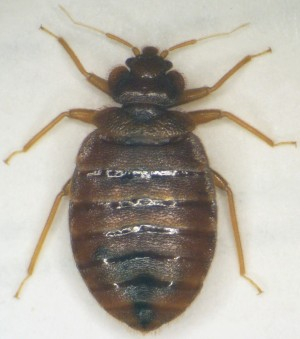Bed Bug
 Scientific Name
Scientific Name
Cimex lectularius
Habitat
The common bed bug, is a bloodsucking parasite of man. They tend not to live on humans and their only contact is for the blood meal. Most blood feeding occurs at night, and they generally seek shelter during the day and become inactive while digesting the blood meal. Bed bugs shelter in a variety of dark locations, mostly close to where people sleep. These include under mattresses, floorboards, carpets, behind paintings, skirting, in various cracks and crevices of walls, within bed frames and other furniture, and behind loose wallpaper. Bed bugs tend to stay in close contact with each other and heavy infestations are accompanied by a distinctive sweet sickly smell. Blood spotting on mattresses and nearby furnishings is often a tell tale sign of an infestation. The bugs apparently locate the host by detecting warmth and carbon dioxide. The bite itself is said to be painless, however the deposition of saliva on the abraded epidermis results in localized wheals or hives. Reactions to the bites may be delayed up to 9 days before lesions appear. Common areas of the body that are affected involve the arms and shoulders.
Life Cycle
Cimex feeds by piercing the host with its mouthparts (hollow tubes). Saliva injected at the time of feeding is associated with local and sometimes widespread hives. There are five juvenile stages known as nymphs, which are miniature versions of the adults in appearance. Each nymphal stage requires at least one blood meal to molt to the next stage and it takes 5-10 minutes for complete engorgement to occur. The entire nymphal development takes 6-8 weeks, while the adult bed bugs can live on average for 6-12 months. There may be several generations per year. All nymphal stages and adults of both sexes require blood for nutrition and development. After mating, each female lays 2-3 eggs a day throughout her lifespan. The cream colored eggs (1mm in length) are cemented on rough surfaces of hiding places, and will hatch around 10 days at room temperature.
Description
Adult bed bugs are about 1/4 inch long and reddish brown, with oval, flattened bodies. The immatures (nymphs) resemble the adults, but are smaller and somewhat lighter in color.
Control
Generally these pests have become less important over the last 50 years with overall improvements in household and personal cleanliness, and with the use of effective insecticides. Resistance to insecticides has been seen and varies by region. Control is achieved by thoroughly cleaning bed cloths, mattresses, and pillows. Insecticide is then used to treat the bed frame, springs, slats, and nearby crevices around doors, windows, and baseboards. Please contact your local county extension office for current information.

